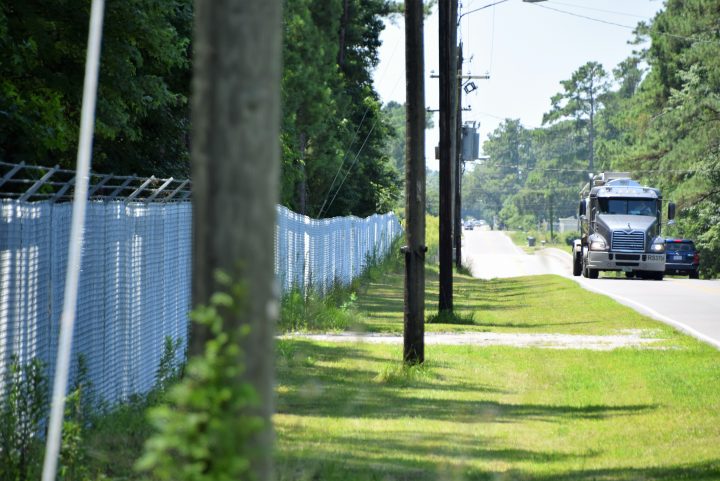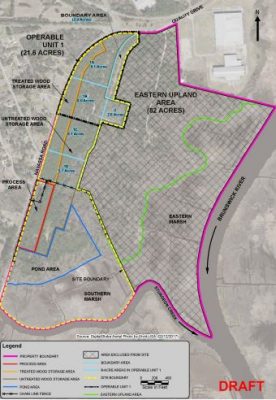
NAVASSA – The U.S. Environmental Protection Agency’s “shocking decision” in its proposal to leave contaminated soil on a portion of the Navassa Superfund site violates a federal act and the community’s civil rights, according to the Southern Environmental Law Center.
The EPA should require a comprehensive cleanup of the former Kerr-McGee Chemical Corp. site, including 21.6 acres of which the agency has proposed a “no remedy” action, the SELC said in a letter it submitted to the agency earlier this month.
Supporter Spotlight
That portion of the site, identified as “operable unit 1,” would be used for commercial, industrial or recreational purposes, under the EPA’s proposed plan the agency released in October.

A move to take no action to clean contaminants within that unit, called OU1, and leaving out the possibility of using the land for future residential use violates the Comprehensive Environmental Response, Compensation, and Liability Act, or CERCLA, the National Contingency Plan and EPA guidance, according to the SELC.
The nearly 50-page letter the law center submitted on behalf of the Navassa Community Environmental and Economic Re-developmental Corp., or NCEERC, states in part that, “despite a clean-up budget of $93 million dollars, documented contamination at OU1, and an anticipated clean-up cost at OU1 of only $3 million, the agency recommended a decision to do absolutely nothing to remediate the documented contamination in OU1.”
That anticipated cost included what was originally 32 acres first identified as OU1, said SELC Senior Attorney Chandra Taylor. The size of the unit was scaled down after testing revealed that contaminants exceeding the national standard were on a portion of the property.
Soil samples show that a little more than 2½ acres within OU1 contain concentrated areas of contaminants that exceed the state threshold, according to the state Department of Environmental Quality, or DEQ.
Supporter Spotlight
For that reason, the state has asked that institutional controls be placed on the 2.6 acres, restricting housing, schools or daycares from being built on that part of the property.
“We argue that (the EPA) prematurely limited development options,” Taylor said. “To leave the contaminated soil there would be an environmental injustice. The NCEERC has been clear that they would like to see a full range of options to be available to the community.”

Erik Spalvins, the EPA’s remedial project manager for the site, defended the agency’s decision, saying that residents and town officials had in the months leading up to the release of the proposed plan expressed the desire to see OU1 developed for commercial or industrial use.
“The heart of the issue is what is the future land use going to be for that property,” Spalvins said. “Many years ago, the agency and the state, we were planning on doing a residential cleanup for part of this site because it’s fairly achievable. It was because of the feedback from the community and mayor and NCEERC that we adjusted our course and changed our land use determination from industrial, commercial and recreational.”

When town residents and officials saw the proposed plan upon its release Oct. 7 it may have prompted a change of heart, he said.
“Until the public meeting there was a pretty strong consensus with the community that they wanted to see commercial industrial,” Spalvins said.
The meeting he referenced was one of the quarterly meetings the EPA hosts in town to update residents on things like soil and groundwater test results and the overall progress of the Superfund process.
During that mid-October meeting, residents and community leaders argued they did not believe residential use was an option in OU1 because agency and state officials did not present it as one.
Spalvins told residents at that meeting that if they had changed their minds, “that is OK.”
“We don’t want to be part of the community losing control of what is happening in that community,” he said in a telephone interview Wednesday. “I don’t want the town to let the concern about the contaminated soil to control or dictate what the land use will be. I do not want the concern about the funding to limit the community’s desires and I don’t want the contamination to limit the community’s desires.”
There are only a few sample locations that would pose a risk for residential use within OU1, he said, adding that additional sampling would be needed to determine the best way to remediate those areas.
“Across the site we could achieve a cleanup that would be suitable for residential use,” he said.
The 250-acre former wood-treatment plant site was added to the National Priorities List of federal Superfund sites in 2010 because creosote contamination was discovered in the groundwater, soil and sediment.
Spalvins said the agency will reach out to Navassa officials to find out whether the town wants to change current zoning and land use plan to reflect residential development as a potential use for the land.
The property is currently zoned heavy industrial by the town.
Spalvins said the record of decision, which is a public document that explains the remediation plan for the cleanup of a Superfund site, will likely be delayed so federal and state officials can “have these conversations with the local government until we can understand what they would like to see in terms of land use.”
Covering 14 square miles, the Brunswick County town of Navassa has at least three “heavily” polluted sites: the former Kerr-McGee wood-treatment plant, the former Estech General Chemical Co. site and the former Cape Fear Meat Packing plant, according to the SELC.
The wood-treatment plant was operated under various companies between 1936 and 1974. Black employees, paid less than their white counterparts, were equally exposed to creosote, a gummy, tar-like substance used to treat and preserve logs.
Some town residents can trace their ancestors back to slaves forced to work in area rice fields before the Civil War.
Navassa’s population is fewer than 2,000 residents, about 70% of whom are black. More than 20% of the town’s population lives below the poverty line, according to the letter.
“If implemented as proposed, the EPA’s No Action alternative will likely have adverse and disproportionate impact on the local community on the basis of race, in violation of Title VI,” the letter states.
Title VI of the Civil Rights Act of 1964 states that no one in the U.S., “shall, on the ground of race, color or national origin, be excluded from participation in, be denied the benefits of, or be subjected to discrimination under any program or activity receiving Federal financial assistance.”
Therefore, the SELC argues, the state must act if the EPA does not.
There has been community support for mixed-use development on the site and the town has identified a possible location for a Gullah Geechee Cultural Center.
The town received a $25,000 grant in 2016 to develop a concept plan for a cultural center and for a program to protect lands significant to Gullah Geechee heritage.
Gullah Geechee are descendants of Africans enslaved on rice, indigo and Sea Island cotton plantations of the lower Atlantic Coast.
The Gullah Geechee Cultural Heritage Corridor runs up the East Coast from Florida to just shy of Jacksonville and extends 30 miles from the coast inland. It is one of 55 designated National Heritage Areas throughout the country and one of two in North Carolina, according to the National Park Service.
“We urge the EPA to make a decision that recognized the history of environmental injustice, the burden borne by the Town of Navassa in hosting this and other contaminated sites, as well as federal, policy, and prior decision guidance,” the SELC letter states. “The EPA should reserve its recommendation for a No Action alternative, and support the most robust clean-up possible for OU1.”
Taylor said the SELC and NCEERC have not discussed their next move should the EPA move forward with its proposed plan.
“It would definitely be the wrong decision,” she said. “The EPA and the state have the opportunity to make sure this community is safe.”








